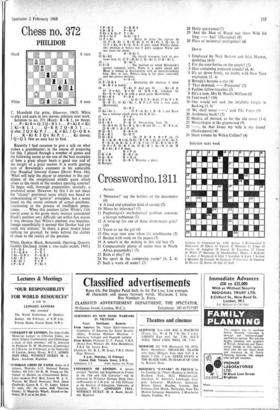Chess no. 372
PHILIDOR
C. Mansfield (1st prize, Observer, 1965). White to play and mate in two moves; solution next week. Solution to no. 371 (Rice): R- R 1, no threat.
I P -Kt 8 = Q; 2 Q - B 3. 1 P - Kt 8 = Kt; 2 Kt-R 1. I Q-R 8; 2 Q-B 3. I ... Q else; 2 Q x Kt P. 1 . . . K X Kt; 2 Q - Q R 4.
I . . . K - Kt 8; 2 Q X Kt P. 1 . . . Kt moves; 2 Q -Q 3. Not an easy key to find.
Recently I had occasion to give a talk on what makes a grandmaster; in the course of preparing for this, I played through a number of games and the following seems to me one of the best examples of how a great player beats a good one and of the insight of a great master. It is worth quoting part of Botwinnik's comment in his admirable One Hundred Selected Gaines (Dover Press 14s), 'What will help the player to orientate in the con- ditions of the complicated middle game which arises as the result of the modern opening systems? To begin with, thorough preparation; secondly, a positional sense. However, by this I do not mean the "classic" positional sense which was based on understanding of "general" principles, but a sense based on the sound estimate of actual positions, functioning in the process of intelligent prepa- ration. . . . When this position [after White's 13th move] arose in the game many masters considered Black's position very difficult; yet within five moves It Was obvious that White's position was hopeless, though superficially it seemed that Denker had not made one mistake.' In short, a great master takes nothing for granted; he looks behind the clichés of chess to the reality of the position.
White, Denker. Black, Botwinnik. Opening, Queen's Gambit Declined. (ussn V. usn radio match, 1945.)
1 P - Q 4 P - Q 4 2 P - Q B 4 P - K 3 3 Kt-Q B 3 P-QB 3 4 Kt - B 3 Kt - B 3 5 B - Kt 5 P x P 6 P - K 4 P - Kt 4 7 P - K 5 P - K R 3 8 B - R 4 P - Kt 4 9 Kt X K Kt P P X Kt 10 B X Kt P Q Kt - Q 2 11 P X Kt. BeUer to delay the capture by 11 P-K Kt 3, . B -Q Kt 2; 12 B -Kt 2, Q-Kt 3; 13 P X Kt, 0 - 0 - 0; 14 0 - 0 after which White's defen- sive position is better; but I don't suppose White saw any cause for alarm.
11 . . . B - Q Kt 2 12 B -K2. . He should transpose back to pre- vious note by .1::! P - K Kt 3, Q - Kt 3; 13 B - Kt 2.
12 Q - Kt 3 13 b .- a . . . The position to which Botwinnik's quoted comment refers: White is a pawn ahead and Black is behind in development with an insecure-looking king. But, in fact, White's ..king is far more vulnerable and this proves decisive.
13. . ._ 0 - 0 - 0 14 P - Q R 4 . . . Overrating his chances; I think B - B 3 is better.
14 . .. P - Kt 5! And not 14 . . . Kt - K 4; 15 P x Kt!, R X Q; 16 Q R x R. followed by Kt - K 4- Q 6 ch with a good game (Botsinnik).
15 Kt - K 4 P - B 4 16 Q - Kt 1 . . . 16 Q - B 2, P - B 6!; 17 Kt P X P. Q - B 2!; 18 Kt- Kt 3, B P x P with a son game (Botwinnik).
16 . . . Q - B 2 17 Kt -Kt 3 . . . 17 P - K Kt 3, B - R 3 and Black has a winning attack along the K R tile, 17 . . . PXP 18 B X P Q - B 3!
19 P - B 3 P - Q 6! Threatening both 20 . . .
Q - B 4 ch; 21 K - R 1, Q x B and 20. . . B - B 4 eh; 21 K - R 1, R x P ch!
20 Q - B 1 B - B 4 ch
21 K - R 1 Q - Q 3! B 4, It x P ch; 23 22 Q - B 4. . . Or 22 B - x Kt ch: 25 K - Kt 3, K x R, R - R 1ch; 24 Kt - R 5, It 27 B - B 4, Q X P; P-K 4:26 B-K 3, P-K 5 ch; 3. Kt - K 4 di; 30
28 P x P, Q-R 5 eh; 29 K-B B x Kt, B X P mate 22 R x P ch 23 i6iR R - R 1 ch 24 Q - R 4 R x Q ch 25 B x R. Q - B 5. Winning a piece.
26 Resigns.


































 Previous page
Previous page